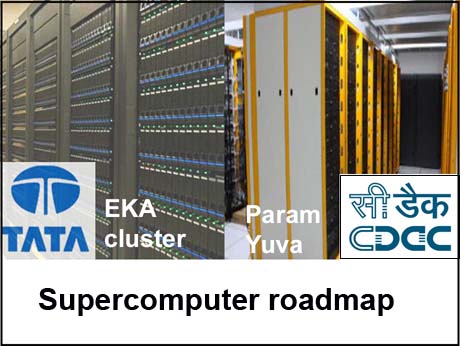
New Delhi, May 24 2016: The Indian government has restated its intentions in the arena of supercomputing, with small tweaks to the earlier-stated policy.
Speaking to the Press Trust of India, two days ago, Ashutosh Sharma, Secretary in the Ministry of Science and Technology, said government has approved the plan of the National Supercomputing Mission, under which, in modification of earlier plans, this will now be a mix of imported and indigenous systems.
Overall control of the Mission, seems to have reverted to the Centre for Development of Advanced Computing, the only agency that has a continuous record of making such high performance machine indigenously for a quarter century with the Param series of supercomputers. The first new supercomputer will come in 2017, Sharma is quoted as saying -- though whether this will be imported or 'made in India' is not clear. He added that 80 supercomputers will be built in the next seven years.
Rs 4500 crores ( Rs 45 billion) had been allotted way back in 201 when the National Supercomputing Mission aimed at enabling India to leapfrog to the league of world-class computing nations, was first mooted. The amount remains the same today -- though its dollar value has shrunk, somewhat.
Last year, government decided that the Mission responsibility was to be shared by two government entities: the Department of Science and Technology (DST) and Department of Electronics and Information Technology (DeitY) with the Centre for Development of Advanced Computing (C-DAC) and the Indian Institute of Science (IISc), Bangalore serving as the twin operational hubs of the project.
Currently, the Supercomputer Education and Research Centre's Sahasrat of the Indian Institute of Science Bangalore's imported Cray XC40 system is the country's most powerful at 901.5 teraflops/sec and has 1376 nodes with 33,024 Xeon cores together with NVIDIA K40 graphic accelerators. The fastest indigenously assembled machine remains the Centre of Development of Advanced Computing (CDAC)'s Param Yuva-II clocking 388.4 teraflops. The once most powerful EKA Cluster at Tata Sons Computational Research Labs, Pune clocking 132.8 teraflops ( 172 teraflops peak) has been left behind by the shifting goalposts of High performance computing and is now no longer in the world's Top 500 computers
Earlier reports
|India rejigs supercomputer grid plans
Bangalore-based IISc super-computer is now India's most powerful